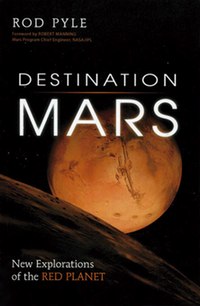Review: Destination Marsby Jeff Foust
|
| Interviews help the book stand out from other books about Mars exploration by providing first-hand accounts of the work on those missions, as well as what drew people into the subject in the first place. |
Pyle provides a chronological progression of missions in the book, starting with Mariner 4’s flyby of Mars in 1965 that shattered earlier, more hospitable visions of the Red Planet, and working his way through to MSL. The emphasis is primarily on American missions to Mars, an understandable choice since most of the successful Mars missions have been by NASA. ESA’s Mars Express, perhaps the most successful non-NASA Mars mission, does get a short chapter, while Soviet/Russian failures are only briefly mentioned in the text.
He leavens the discussion of the various missions with chapters interviewing some of the key engineers and scientists involved in these missions. These chapters help the book stand out from other books about Mars exploration by providing first-hand accounts of the work on those missions, as well as what drew people into the subject in the first place. These chapters include some interesting, little-known vignettes: Robert Brooks, for example, describes how they nearly lost Mars Global Surveyor when a computer glitch caused the spacecraft to perform a course correction maneuver twice while lowering its orbit around the planet. Only some hard work by the spacecraft team (and “lax speed-limit enforcement” on local freeways as the spacecraft team raced to JPL in the early morning hours) saved the mission.
The book does touch upon the future of Mars exploration after Curiosity, but some elements of that section have been overtaken by more recent events. The book refers to US cooperation on ESA’s ExoMars mission, yet earlier this year NASA announced it was terminating its agreement to work with ESA on that mission, sending the Europeans scrambling to find new ways to carry out the planned orbiter and lander missions. Indeed, the future of NASA’s Mars exploration programs after Curiosity and the 2013 MAVEN orbiter remain uncertain, as the agency effectively reboots its exploration plans. As that future—both of long-term exploration and the short-term fate of Curiosity—unfolds, Destination Mars offers a good review of the history of spacecraft exploration of Mars up to now for those interested in learning more about the missions and the people who made them possible.
